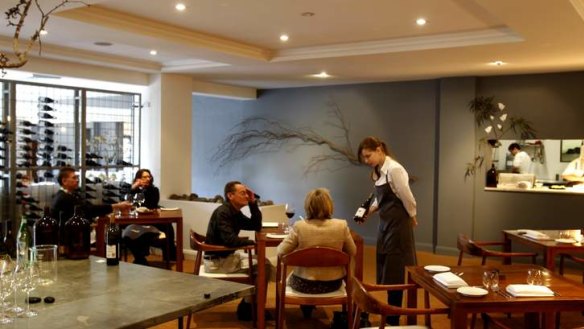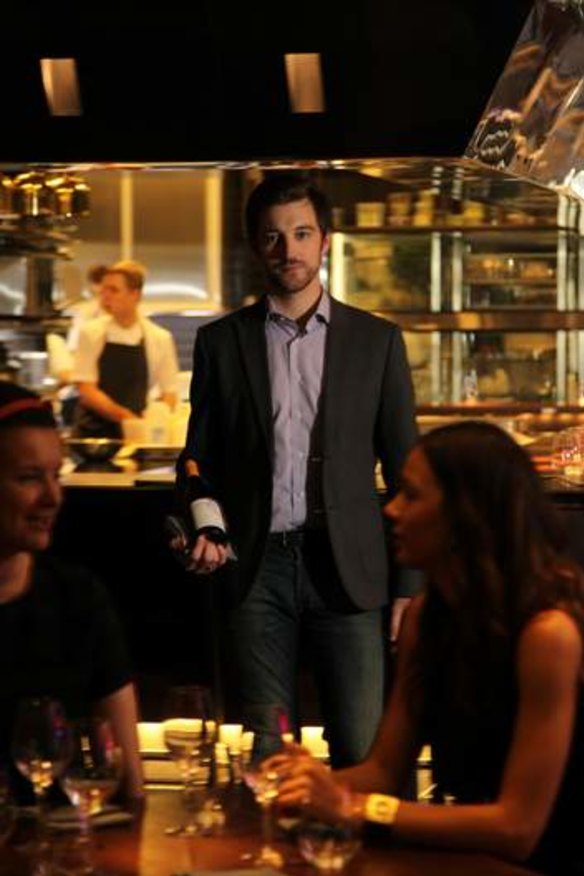The Sydney Morning Herald Good Food Guide 2014: the wine awards
Modern dining tastes are changing and, thankfully, the choice of degustation drinks has never been better.

Wine lists are no longer just wine lists. Matching degustation drinks increasingly include great beers, Japanese sakes, quality ciders and even fruit juices. At the same time, the choice of imported wine in Australia has expanded enormously. This means the sommelier's job is increasingly complex, demanding greater levels of passion and commitment. Twenty years ago, by-the-glass wine was the exciting new thing: now, sommeliers are pouring things you've never heard of. And offering it in two sizes of glass, or even a carafe. The proliferation of importers has meant Australian wine is looking neglected in some top restaurants. The big lists have gotten bigger, although they're in the minority, while small lists have become tighter and more inventive. There's never been a better time to be a wine lover dining out.
Best small wine list
Baccomatto Osteria
The art of designing a really good small list is one of the joys of modern dining. Gone are the bad old days of predictable, boring selections that seemed to have been chosen with the eyes closed, oblivious to the fact that the bottle shop down the road offered the same stuff at half the price.
On the contrary, this is a tiny list and I wanted to drink everything on it.
The list was put together by Gabrielle Webster, who came to prominence at Newtown's Bloodwood, where she won best small wine list in our 2012 awards.

A small list can be anything up to 100 listings, but Baccomatto's really is teensy, with just 39 wines, more than half of which are available by the glass. Despite its brevity, it manages to offer ''discovery'' bottles, such as Ca' del Baio chardonnay from Piedmont.
And it's very affordable. Most of the bottles are priced between $35 and $65, and there are only two wines at three figures: an Andrea Oberto barolo at $100 and an Egly-Ouriet champagne at $180.
Pricing is also designed to relax the hinges on our wallets. A Matchbox Wine Co riesling, for example is $30 retail and $45 on the list. A Cullen semillon sauvignon blanc is marked up a little more: it's $35 retail and $65 on the list. Gladstone Vineyards 12,000 Miles pinot noir is $25 retail and $55 on the list, so there is a varied, but always reasonable, mark-up. By-the-glass wines are a fifth the price of the full bottle, which is a normal ratio.
Every wine is there for a reason. It's a clever list indeed.
Best regional list
Biota Dining, Bowral
It sounds like a no-brainer, but it doesn't always happen: a great restaurant must have a great wine list; otherwise, you're only getting a partially great experience. I love this restaurant and its wine list. It's quite small, with 113 listings, but it's concise and tight.
And it has a strong regional component, with a selection of the finest wines of the Southern Highlands as well as Canberra district and parts of NSW not far distant, such as Hilltops and Orange. There's a definite local feel, which the judges liked. A special 20-wine feature is made of three local wineries: Centennial, Tertini and Pulpit Rock.
There's also a noticeable bias towards food-friendly wines - in other words lighter, finer, more savoury and less-oaky styles. Australian wines are narrowly in the majority and there's an astute sprinkling of interesting wines from France, Spain, Italy and New Zealand. There are 17 wines by the glass.
In keeping with the restaurant's philosophy, wines from low-input producers are given prominence: 57 of the wines are from ''sustainable, organic, biodynamic or natural'' producers, and these have asterisks. This is not the place to debate whether words such as ''sustainable'' and ''natural'' should be explained more fully, but there's no doubt restaurateurs and diners are increasingly interested in sustainable produce. And no doubt your sommelier or waiter can give you more details if you ask.
This is an exciting small wine list, totally appropriate to the fare you'll be served, and with a truly regional flavour.
Wine list of the year
Monopole
Ho hum. Another year, another great Nick Hildebrandt wine list. No stranger to the Good Food awards, sommelier Hildebrandt has nabbed the biggie again with his new list at Bentley sibling, Monopole. Although slightly smaller than Bentley's tome, at 600 listings it's substantial, but it's so well laid-out and easy to navigate that you won't notice.
Hildebrandt's fingerprints are all over it, from the emphasis on small makers, the obscure and the ''alternative'' to the wines that he thinks go best with the food. So think Jura (39 wines - an entire page!), riesling, chenin blanc (16 wines!), chablis (24, featuring Raveneau and Dauvissat), and lighter-bodied reds, especially gamay and pinot noir.
Yes, riesling is a great food wine - but, oh dear, there are only six Aussies among the 34 wines. But then I spot the Trimbach feature with 14 Clos Ste Hunes and Frederic Emiles.
There's a whole page of beaujolais and other gamays, featuring the great Jean Foillard. Do you fancy a pinot noir? There are three pages, two of which are burgundies, and the brilliant Adelaide Hills producer Anton von Klopper's Lucy Margaux wines are featured.
Organic, bio and so-called ''natural'' wines are in evidence, and perhaps the most extreme of these, ''orange'' wines (white grapes fermented with their skins) have 15 listings.
I love the ''grower'' champagne feature page of 20 wines from the likes of Diebolt-Vallois, Selosse and Cedric Bouchard. Even more, I love the fact there are 27 offerings by the carafe (375 millilitres) or glass (120 millilitres) - not only table wines but sparkling, sherry and sake, and all interesting.
I don't care how much you know about the wines of the world, you'll receive an education when you dine at Monopole.
Champagne Pol Roger Sommelier of the year
Richard Hargreave, Momofuku Seiobo
For a man still on the right side of 30, Richard Hargreave is already an accomplished sommelier.
He was dux in the Court of Master Sommeliers exam last year, and after working in Britain and Sydney restaurants Quay and Bilson's, he was selected as head sommelier at Momofuku Seiobo, a restaurant that has taken Sydney by storm over the past 18 months.
The wine list, which has just under 100 listings, is as out of the mainstream as the food. Quirky, esoteric and challenging would not be inappropriate descriptions. There are only a handful of Australian wines, the rest are a United Nations of wine-producing countries, spanning South Africa, Slovenia, France, Italy, Austria, Germany and New Zealand.
The regions are even more eye-opening: Oslavia and Maremma (Italy) and Jura, Gaillac and Corsica (France) for starters. For most diners, their next harslevelu from Swartland will be their first. Not to mention gringet from the Savoie. But you'll find them, as well as groslot from Anjou and cannonau from Sardinia, on Hargreave's free-ranging list.
Not only does Momokufu specialise in eccentric varieties and regions, but the wines are likely to be from organic or biodynamic growers who are inclined towards ''natural'' or even ''orange'' wine styles. There are no fewer than 10 ''orange'' wines listed.
Such wines need to be explained to diners, and this is where the sommelier comes in. Not only does Hargreave have to be across all of these weird and out-there wines in order to select them in the first place, he must then know how they work with the fare coming from the kitchen and be able to explain and ''sell'' them to sceptical diners.
Hargreave is on record as saying his biggest frustration is customers who won't take advice from him because of his age. It's an entrenched belief that wine knowledge only comes with age, which the army of young sommeliers working in top restaurants is rapidly changing.
Many diners might be frustrated at not being able to find anything they know on such a wine list, but this is where the sommelier comes in.
One of his tools of trade is the paired degustation, where each course has a wine matched with it. Two sizes of pour are offered, and there is a choice between an alcoholic and a fruit-juice degustation.
Hargreave's colleagues have great respect for him: they say he has a natural ability to put diners at ease with wine selection. ''He's a gentle, kind, quietly intelligent kind of guy and takes time to explain wine styles to people. He's extremely well-liked by peers and known for his keen but off-beat approach to wine, challenging norms and inspiring younger sommeliers through his creative approach to list and by the glass selection,'' a friend says. ''There's a feeling at Momofuku that dining there is an 'experience' over a complex meal and Richard provides part of the theatre through his quixotic and brave list.''
This most certainly is no ordinary eating and drinking place, and it takes an exceptional talent to make it all work. Congratulations, Richard Hargreave.
Restaurant reviews, news and the hottest openings served to your inbox.
Sign up